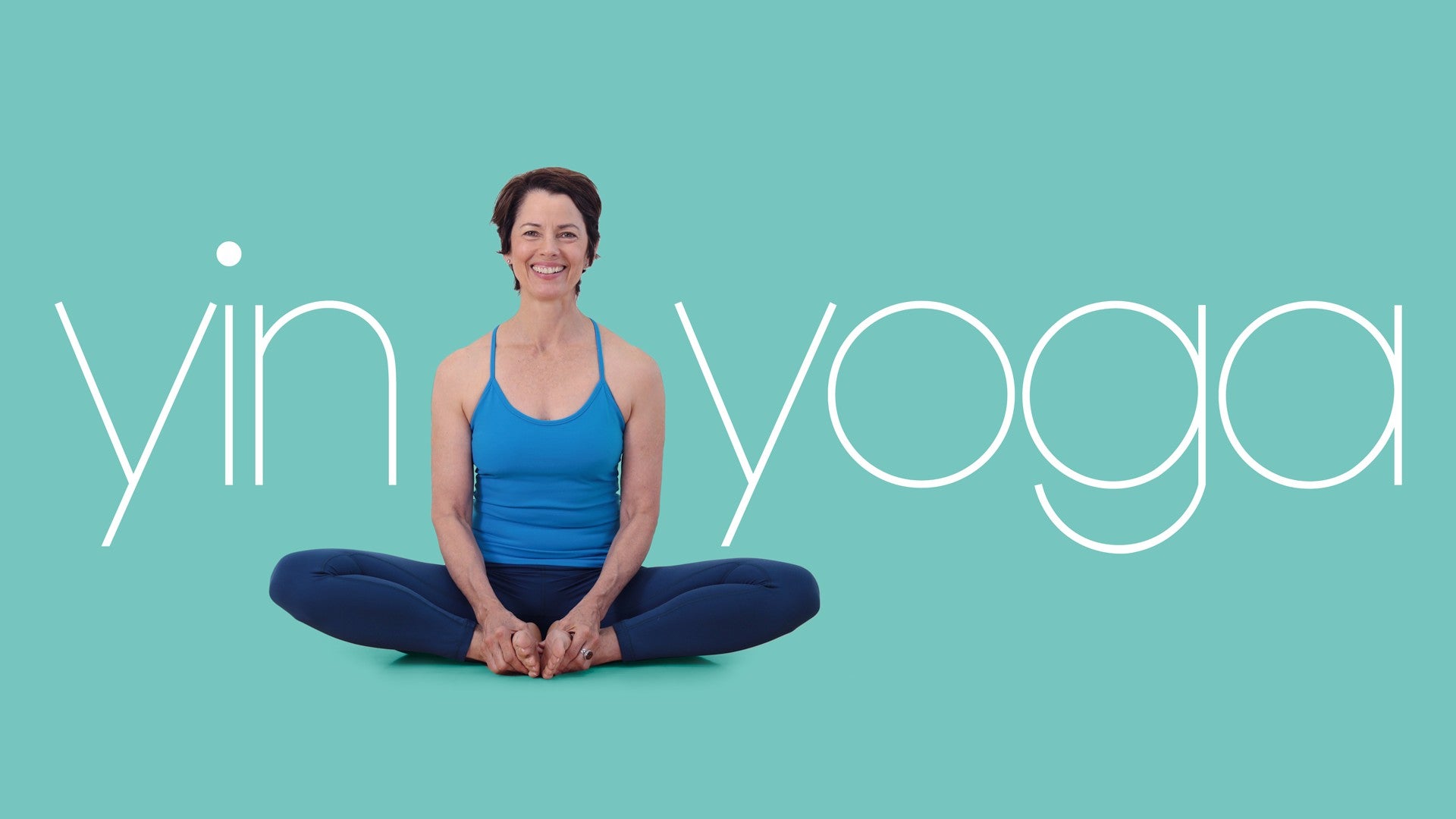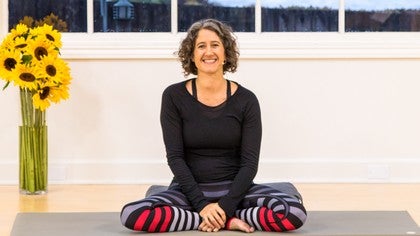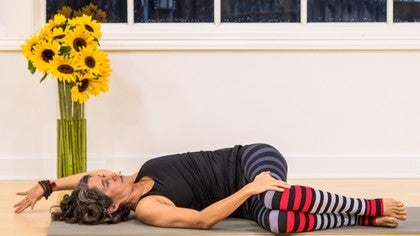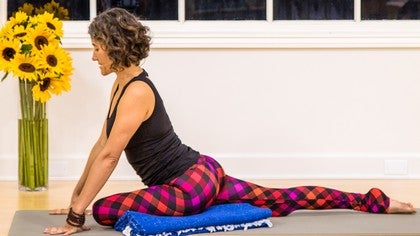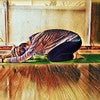Description
About This Video
Transcript
Read Full Transcript
(gentle waves crashing) So let's connect on the principles of what makes a yoga practice yin. Now as we've already discussed a little bit in our introduction to the show, yin is a relative term. Like, yin doesn't make any sense, unless it's compared to something that might be more yang. So a yin yoga practice is yin relative to a more yang like activity. But compared to an afternoon nap, it's an athletic endeavour.
Now there are three primary principles that generally are considered to be what makes something yin. And that is that we offer ourselves to the postures for a more extended period of time, so anywhere from two to five minutes or longer. We're offering ourselves to the posture in a more static, passive, stiller way, than maybe we might in a more athletic yang muscular practice. And then we're offering ourselves to the posture at what we usually call an appropriate edge. So let's unpack each of these three principles a little bit.
So longer holds, now the play is, with a longer hold, one of the main ideas behind this is that, the asana practice is supposedly designed to prepare us for meditation. Particularly in some disciplines seeded meditation. It's impossible to prepare for seeded meditation if you've never actually sat still. And so the longer holds of the yin practice give us these beginning bite sized moments of offering ourselves towards stillness. Letting ourselves be in a position without moving right away, okay.
And so the two to five minutes, some of that has roots in connective tissue theory, which I'm a little less interested in, in just more like, what is it like to start to accept, and open and increase our capacity to be in a situation. And as we move through these practices, um, they'll progressively, the holds will progressively, throughout the practices, get a little bit longer. But that doesn't mean you have to be there just as long. So your internal clock is way more important than the one being offered from the outside. Now, in cases of holding things passively, this can sometimes be mistaken as rigidly, or without movement.
That's not the case. Again, it's just this invitation to start to, allow what we perceive as the external, to still slightly so that we become more sensitive to the internal movements. And as we offer ourselves to these shapes more, for longer periods of time, more passively, you will inevitably become more intimate with the immense movement internally. Whether you become more intimate with the movements of your mind, so your mental thoughts, your emotions, your feelings, or even your heartbeat, your blood flow, your breath. So things never stop moving.
We're just becoming more sensitive to the subtler. And also with, when it's said to hold things for long periods of time, passively, you're never holding where there's extreme pain. You know in yoga we talk sometimes that there's good and bad pain. And it's one of the guiding questions within the yoga practice, is, is this pain good for me? And generally, this is a general rule of thumb, but that dull achy kind of ah, feeling is usually okay.
That, ah, hot, sharp, specific nervy like, (imitating metal squeaking) that's generally not okay. So, you're finding the shape, okay, where you can hold for a long period of time, passively, and that brings us to the third point, at an appropriate edge. Because it's, it's a tricky thing. Like, as long as you have something to work on, as long as the mind feels like it has a project to work on, it can usually be held. Okay, so, so we all have different ranges of motion, it has a lot to do with how we came out of the womb, combined with our day job.
Okay. But really, truly, okay, at the appropriate edge, you're finding a place where you can maintain a quality of ease. Because really, like, more and more research shows that, what seems like flexibility is much more a quality within the nervous system., within the heart and the mind, than anything to do with the muscles, the bones, the ligaments and the tendons. And so if you're at, in a position and you're holding, and you're fighting and you're angry, and you're pissed off, all you're doing is getting better at being angry, pissed off and irritated and tight. So we want to be able to be in places where we can like, keep it soft in the face, kind in the eyes, easy in the breath, okay, which doesn't mean you're not being challenged.
But continually, that's the play. And that brings me to, kind of, even though I mentioned only three principles of the practice, the face is an amazing dashboard instrument as you practice. So the vagus nerve which we've talked a lot about in different shows, and if when I say vagus nerve you're not sure what I mean, you might check out inner workings, or anatomy for yogis, it gets mentioned a lot in those shows. It's one of our primary nerve of our parasympathetic, that it's also known as the tenth cranium, and it comes out and it touches all the, the sensor organs in the face. The mouth, the nose, the eyes, the ears, and, and so if you can feel a tightness in your face as you're practicing, it indicates that you're in too deep.
And sometimes you can just soften your face. And sometimes you just need to back out a little bit, adjust. Like find a more appropriate relationship, okay. Now the breath, in the practice, changes all the time. And generally I find that the spicier the situation you're meeting, okay, and the newer you are to the practice, let your breath deepen more.
So, it's kind of like, sometimes out there in the forest fires, so we live out here in California, so we're intimate with fires. And sometimes the way they battle with forest fires, is they actually set other fires, okay, to (inhales sharply) pull the oxygen out of the system. And so sometimes if you're feelings something quite spicy, or something quite intense, whether that's physical, mental or emotional, a deeper, bigger, more ujjayi like breath, okay, will help meet the situation. As you continue to practice, you'll find that a quieter, softer, more natural breath might lead you to a greater sensitivity of what's going on. The key as always in yoga, though, is to be willing to meet the situation at hand, and not choose a particular theoretical principle, as something that you're holding on to.
Okay, so let's just review. The way these practices are designed, longer holds, somewhat, more static, passively, more an offering of stillness, and at an appropriate edge. There'll be another episode on variations and modifications. So you can find out how to use props, and how all that might work. But these are the primary principles that guide us.
And yet, always, within yoga, the number one principle that guides you, is how it feels to you. You're gonna know better than anybody else and how you feel after the posture, and how you feel later in the day. Or how you sleep at night. Or how your, your relationships in your life, are being reflected will really tell you, if your practice is on the right track. Okay.
Stay close, nice to be here together. Love.
Yin Yoga: Kira Sloane
Comments
At around 4:35 you mentioned that more and more research shows that flexibility is more a quality of the nervous system than of muscles, tendons, etc.. Fascinating! If you have any papers, articles, or short book recommendations or links exploring this research, I'd love to check them out!
Thanks!
Spencer
http://breakingmuscle.com/mobility -recovery/stretching-doesnt-work-th e-way-you-think-it-does
You need to be a subscriber to post a comment.
Please Log In or Create an Account to start your free trial.
